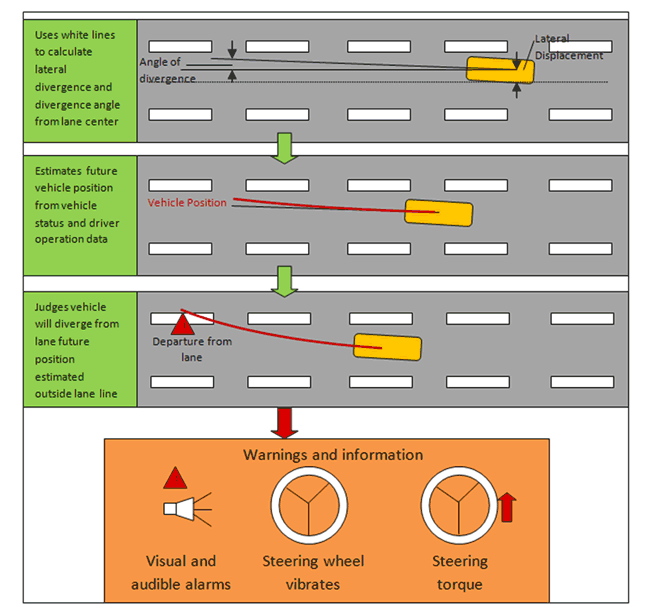Lane Departure Warning Systems
- Basic Description
-
Lane departure warning systems monitor the position of the vehicle and warn the driver when the vehicle starts to drift out of its lane, unless the directional signal is in use or the vehicle speed is below a certain threshold. Unintentional lane departure can be caused by driver distraction, inattention, drowsiness, or even adverse weather conditions and can result in serious head-on collisions. According to the National Highway Traffic Safety Administration (NHTSA), 40-60% of all traffic accidents in the U.S. with determined causes are a direct or partial result of running off the road or inadvertently leaving the lane.

These systems generally employ a video sensor positioned above the rear view mirror that detects lane markings. The camera takes an image of the road ahead of the car during the day or within the headlight beams at night. This visual image is sent to an electronic control unit, where it is analyzed. The lane markings are identified and subsequent changes are recorded. If the vehicle is threatening to stray outside the limits of the lane, the system alerts the driver with an audible alarm and by vibrating the steering wheel or seat cushion. The system takes the vehicle's speed into account, providing a warning earlier when the vehicle is traveling at higher speeds, so the driver has adequate time to correct the steering before the lane markings are crossed.

Lane departure warning systems monitor the turn signal’s status and issue lane
departure warnings only when the driver does not use the vehicle’s turn signal in the
direction of the lane change. In the most advanced systems, if no action is taken by the driver
after the warning is given, a counter steering torque is applied to the steering wheel either by way of the electronic steering system or by applying braking force to a steerable road wheel of the vehicle causing the car to return to a safe position. These systems are sometimes referred to as Lane Keeping Assistance systems.
These systems can be found on a growing number of new cars, particularly high-end luxury models. There are also systems available that can be added to older cars, by means of an existing rear-facing camera, or by a unit that mounts to the dash or windshield. Applications for some smart phones allow them to be used as lane departure warning systems when the phone is placed in a dash-mounted holder. The phone uses its camera and software to determine if the car is drifting from a lane and issues an audible warning.
- Sensors
- Vehicle speed sensor, optical or infrared image sensor, turn signal sensor
- Actuators
- Audible warning alarm, visual indicator, steering wheel vibrator
- Data Communications
-
- Communication with ECM: CAN bus
- Image sensor communication: AV IN*4
- Control Panel (LCD) communication: NTSC/I2C
- Manufacturers
-
Aisin, Bendix,
Bosch,
Continental,
Delphi,
Denso,
Hella,
Lexus,
Mobileye, TRW, Wabco
- For More Information
- [1] Lane Departure Warning System, Wikipedia.
- [2] AutoVue, Lane Departure Warning System, Philip Reed, Edmunds.com, May 5, 2009.
- [3] 2010 Prius Lane Assist Feature, YouTube, July 9, 2009
- [4] Lane Detection on the iPhone, The University of Auckland, 2009.
- [5] IIHS: Avoidance Systems Could Cut Fatal Crashes By One-Third, The Car Connection, May 25, 2010.
- [6] Lane Departure Warning System, Mazda Australia website.
- [7] Volvo - Lane Departure Warning, YouTube, Sep. 21, 2012.
- [8] Lane Departure Warning (LDW), YouTube, Dec. 9, 2015.
|

